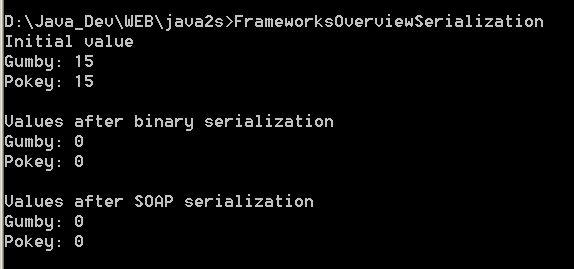C# Serialization

/*
A Programmer's Introduction to C# (Second Edition)
by Eric Gunnerson
Publisher: Apress L.P.
ISBN: 1-893115-62-3
*/
// 32 - .NET Frameworks Overview\Serialization
// copyright 2000 Eric Gunnerson
// file=serial.cs
// compile with: csc serial.cs
using System;
using System.IO;
using System.Collections;
using System.Runtime.Serialization;
using System.Runtime.Serialization.Formatters.Binary;
using System.Runtime.Serialization.Formatters.Soap;
public class FrameworksOverviewSerialization
{
public static void Main()
{
MyRow row = new MyRow();
row.Add(new MyElement("Gumby"));
row.Add(new MyElement("Pokey"));
Console.WriteLine("Initial value");
Console.WriteLine("{0}", row);
// write to binary, read it back
Stream streamWrite = File.Create("MyRow.bin");
BinaryFormatter binaryWrite = new BinaryFormatter();
binaryWrite.Serialize(streamWrite, row);
streamWrite.Close();
Stream streamRead = File.OpenRead("MyRow.bin");
BinaryFormatter binaryRead = new BinaryFormatter();
MyRow rowBinary = (MyRow) binaryRead.Deserialize(streamRead);
streamRead.Close();
Console.WriteLine("Values after binary serialization");
Console.WriteLine("{0}", rowBinary);
// write to SOAP (XML), read it back
streamWrite = File.Create("MyRow.xml");
SoapFormatter soapWrite = new SoapFormatter();
soapWrite.Serialize(streamWrite, row);
streamWrite.Close();
streamRead = File.OpenRead("MyRow.xml");
SoapFormatter soapRead = new SoapFormatter();
MyRow rowSoap = (MyRow) soapRead.Deserialize(streamRead);
streamRead.Close();
Console.WriteLine("Values after SOAP serialization");
Console.WriteLine("{0}", rowSoap);
}
}
[Serializable]
public class MyElement
{
public MyElement(string name)
{
this.name = name;
this.cacheValue = 15;
}
public override string ToString()
{
return(String.Format("{0}: {1}", name, cacheValue));
}
string name;
// this field isn't persisted.
[NonSerialized]
int cacheValue;
}
[Serializable]
public class MyRow
{
public void Add(MyElement my)
{
row.Add(my);
}
public override string ToString()
{
string temp = null;
foreach (MyElement my in row)
temp += my.ToString() + "\n";
return(temp);
}
ArrayList row = new ArrayList();
}
Related examples in the same category